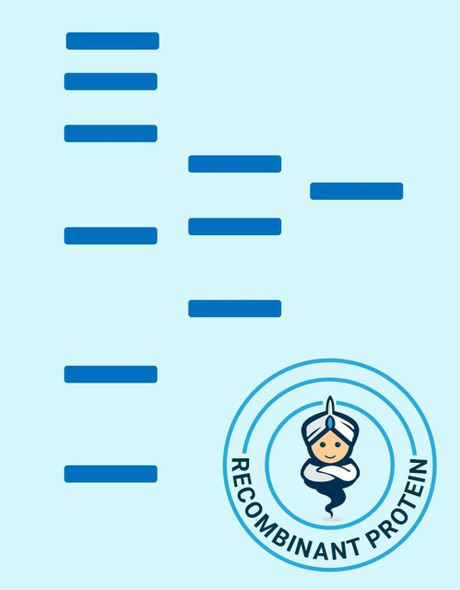Description
| Product Name: | Human CACYBP Recombinant Protein |
| Product Code: | RPPB5863 |
| Size: | 25µg |
| Species: | Human |
| Target: | CACYBP |
| Synonyms: | S100A6BP, S100A6 Binding Protein, GIG5, PNAS-107, RP1-102G20.6, SIP, CACYBP, hCacyBP, Siah-interacting protein, MGC87971. |
| Source: | Escherichia Coli |
| Physical Appearance: | Sterile filtered colorless solution. |
| Formulation: | CACYBP Human solution containing 20mM Tris�HCL pH-8, 1mM DTT, 0.1M NaCl & 10% glycerol. |
| Stability: | Store at 4°C if entire vial will be used within 2-4 weeks. Store, frozen at -20°C for longer periods of time.�For long term storage it is recommended to add a carrier protein (0.1% HSA or BSA).Avoid multiple freeze-thaw cycles. |
| Purity: | Greater than 85% as determined by SDS-PAGE. |
| Amino Acid Sequence: | MGSSHHHHHH SSGLVPRGSH MQQKSQKKAE LLDNEKPAAV VAPITTGYTV KISNYGWDQS DKFVKIYITL TGVHQVPTEN VQVHFTERSF DLLVKNLNGK SYSMIVNNLL KPISVEGSSK KVKTDTVLIL CRKKVENTRW DYLTQVEKEC KEKEKPSYDT ETDPSEGLMN VLKKIYEDGD DDMKRTINKA WVESREKQAK GDTEF |
CACYBP (calcyclin binding protein) participates in calcium-dependent ubiquitination and subsequent proteosomal degradation of target proteins. CACYBP acts as a molecular bridge in ubiquitin E3 complexes. CACYBP is involved in the ubiquitin-mediated degradation of beta-catenin.
CACYBP Human Recombinant produced in E.Coli is a single, non-glycosylated,polypeptide chain containing 205 amino acids (1-185a.a.) and having a molecular mass of 23.4 kDa. CACYBP protein is fused to a 20 amino acid His tag at N-terminus and is purified by standard chromatography.
| UniProt Protein Function: | CACYBP: a nuclear/cytoplasmic protein involved in calcium-dependent ubiquitination and proteosomal degradation of target proteins. A possible molecular bridge in ubiquitin E3 complexes. Participates in the ubiquitin-mediated degradation of beta-catenin (CTNNB1). Interacts with proteins of the S100 family at physiological calcium concentrations. Component of some large E3 complexes and interacts directly with SIAH1, SIAH2 and SKP1A. Cytoplasmic at low calcium concentrations. In neuroblastoma cells, after a retinoic acid (RA) induction and calcium increase, it localizes in both the nucleus and cytoplasm. The nuclear fraction may be phosphorylated. Two alternatively spliced isoforms have been described. |
| UniProt Protein Details: | Protein type:Adaptor/scaffold; Ubiquitin conjugating system Chromosomal Location of Human Ortholog: 1q24-q25 Cellular Component: nucleoplasm; neuron projection; nuclear envelope lumen; cytoplasm; beta-catenin destruction complex Molecular Function:protein binding; protein homodimerization activity Biological Process: positive regulation of DNA replication; cardiac muscle cell differentiation; aging |
| NCBI Summary: | The protein encoded by this gene is a calcyclin binding protein. It may be involved in calcium-dependent ubiquitination and subsequent proteosomal degradation of target proteins. It probably serves as a molecular bridge in ubiquitin E3 complexes and participates in the ubiquitin-mediated degradation of beta-catenin. Two alternatively spliced transcript variants encoding different isoforms have been found for this gene. [provided by RefSeq, Jul 2008] |
| UniProt Code: | Q9HB71 |
| NCBI GenInfo Identifier: | 46576651 |
| NCBI Gene ID: | 27101 |
| NCBI Accession: | Q9HB71.2 |
| UniProt Secondary Accession: | Q9HB71,O60666, Q5R370, Q5R371, B2ZWH2, B3KSF1, |
| UniProt Related Accession: | Q9HB71 |
| Molecular Weight: | 21,228 Da |
| NCBI Full Name: | Calcyclin-binding protein |
| NCBI Synonym Full Names: | calcyclin binding protein |
| NCBI Official Symbol: | CACYBP�� |
| NCBI Official Synonym Symbols: | SIP; GIG5; PNAS-107; S100A6BP�� |
| NCBI Protein Information: | calcyclin-binding protein; hCacyBP; S100A6-binding protein; Siah-interacting protein (SIP); growth-inhibiting gene 5 protein |
| UniProt Protein Name: | Calcyclin-binding protein |
| UniProt Synonym Protein Names: | S100A6-binding protein; Siah-interacting protein |
| Protein Family: | Calcyclin-binding protein |
| UniProt Gene Name: | CACYBP�� |
| UniProt Entry Name: | CYBP_HUMAN |






